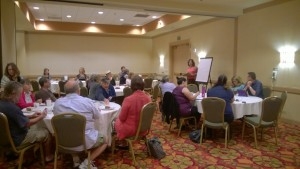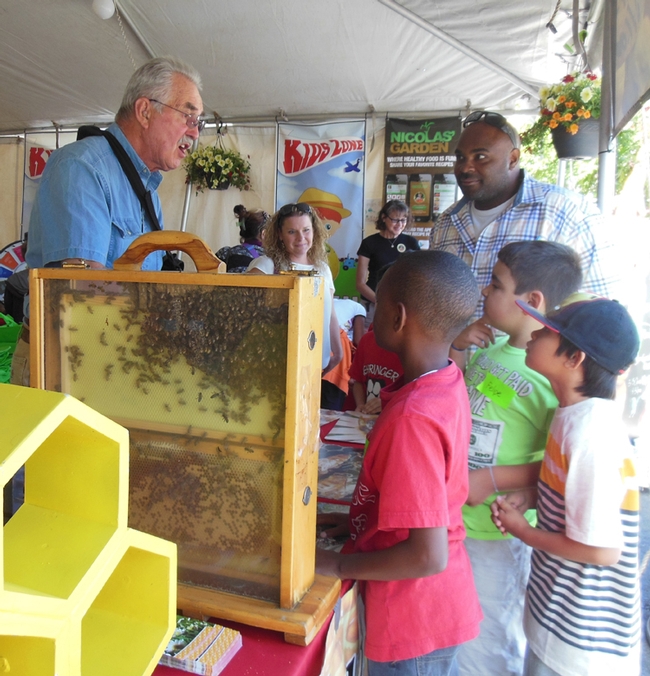UC Food and Agriculture Blogs
Managing Weeds Under Drought Conditions
[From the August 2014 issue of the Green Bulletin, a newsletter for landscape and structural professionals] While one of the best methods to reduce weeds is to not water them, there are some that survive even in drought conditions (Fig. 1). As we...
San Diego farmers: Help plan California Small Farm Conference
Do you live or work in the San Diego area and have a passion for small farms? We need your connections and expertise to help plan the 28th California Small Farm Conference!
The conference will be March 7 - 10, 2015 at the Marriott Mission Valley in San Diego County.
Attracting approximately 500 participants yearly, the California Small Farm Conference is the state's premier gathering of small-scale farmers, farmers' market managers, university researchers, federal and state agriculture agencies, agriculture students, food policy advocates, consumers and others.
Each year we recruit local farmers, farming organizations, farmers' market managers and others to help us plan the Conference and focus on important local issues.
The important work of the Local Planning Committee volunteers ensures the success of the California Small Farm Conference. We are looking for dedicated individuals with a passion for agriculture, who work or live in the San Diego area, to join our 2015 Local Planning Committee!
There are still openings for several volunteers to participate in planning by taking leadership roles on conference committees. These "super volunteers" will receive complementary registration and meals at the conference.
We need your input on local contacts for speakers, workshop topics, field tours and the tasting event! The second meeting of the Local Planning Committee will be held on Monday, September 15 at the San Diego Marriott Mission Valley from 12:30 – 2:30 p.m.
Click here to RSVP to the September 15 Local Planning Meeting.
Questions? Contact Jennifer Roth, Conference Coordinator, 916-508-8937 or jroth@californiafarmconference.com
Discover California Farms... ...at California Fairs!
A guide for specialty crop promotion and education at California district and county fairs
Tip #1: Bring in the bees!
Almost everyone in California enjoys our county and district fairs, but most people attending California fairs don't know much about local farmers or the crops that are grown in their own region. Many fairs and members of California agricultural communities are trying new ways to connect local farmers with fair attendees.
Specialty crops – fruits, vegetables, nuts, herbs, flowers, honey, and the products created from them – are a big deal in California. California farmers feed their local communities, provide about half of the fruits and vegetables eaten in the United States, and export their crops and products around the world. Fairs attract thousands of visitors from urban, suburban and even rural communities who have never met a farmer or visited a farm and often do not know what is growing in fields and orchards surrounding their communities. California fairs offer opportunities for the agricultural community to connect with these visitors.
In 2013 and 2014, the California Department of Food and Agriculture's Division of Fairs and Expositions collaborated with the University of California Small Farm Program to organize 20' by 40' interactive, fun and educational exhibits at four different California District Fairs to teach about local farms, crops and farmers' markets and promote fresh fruits, vegetables, nuts, herbs, flowers and honey to fair-goers.
Project staff created a guide to specialty crop education and promotion at county fairs, based on the experience of the many farmers, educators, fair officials and community groups participating in that project. The guide is funded by a California Department of Food and Agriculture Specialty Crop Block Grant, as part of the "Mobile Agriculture Education Exhibit" Project.
The 22 page guide is available here as a downloadable pdf file:
Discover California Farms... ...at California Fairs!
A Healthy Start Back to School
As summer is quickly coming to a close, and most kids have already headed back to school or will be returning in the next couple of weeks, integrated pest management will be an expected and important tool for the upcoming school year. Classrooms,...
The devil -- er, bacteria -- made me do it
Many people worry about the outside of their gut – watching their weight and suffering through sit-ups in search of six-pack abs.
Research from UC San Francisco is showing that we also should pay attention to what's inside the gut.
Gut bacteria may affect both our cravings and moods to get us to eat what they want, and often are driving us toward obesity, according to an article published this month in the journal BioEssays.
Researchers concluded from a review of recent scientific literature that microbes influence human eating behavior and dietary choices to favor consumption of the particular nutrients they grow best on, rather than simply passively living off whatever nutrients we choose to send their way.
“Bacteria within the gut are manipulative,” said corresponding author on the paper Carlo Maley, director of the Center for Evolution and Cancer with the Helen Diller Family Comprehensive Cancer Center at UCSF. “There is a diversity of interests represented in the microbiome, some aligned with our own dietary goals, and others not.”
We also can influence this diverse community of microbes, collectively known as the gut microbiome, by altering what we ingest, Maley said, with measurable changes in the microbiome within 24 hours of diet change.
“Our diets have a huge impact on microbial populations in the gut,” Maley said. “It's a whole ecosystem, and it's evolving on the time scale of minutes.”
The gut is a growing field for research.
Michael Fischbach, a UCSF assistant professor of bioengineering and therapeutic sciences, studies gut bacteria and how they could help reveal the causes and new treatments for Crohn's disease and obesity.
“When I look at a person, I don't just see a warm, shiny human being,” Fischbach said. “I see bacteria crawling all over you and living on every surface that's exposed and not exposed in your entire body. And you're lucky that they're there because these bacteria do very important things for you. They make your immune system function properly. They help you digest foods. And they produce important chemicals that serve as vitamins for your body.”
With advancements in genetic sequencing technology, Fischbach and colleagues are mining gut bacteria for natural products – small molecules from microbes – that could hold the key for treating diseases.
“You used to have to travel to the coast of Palau to mine the ocean sediment for drugs,” Fischbach said. “Now we can just check our gut!”
Fischbach discussed his gut research with collaborator Justin Sonnenburg, a Stanford University microbiologist with degrees from UC Davis and UC San Diego, at the recent New York Times Health for Tomorrow conference at UCSF Mission Bay Conference Center.
“The beauty of being in basic research is you don't know where you're going to end up,” Fischbach said after their panel presentation. “It's nice to be on a journey where you don't know where the ship lands. I hope it's going to improve human health.”
Read more:
-Do gut bacteria rule our minds?, UCSF
-Our microbiome may be looking out for itself, New York Times
-The next frontier of medicine, Slate
-Culturing for cures, UCSF







